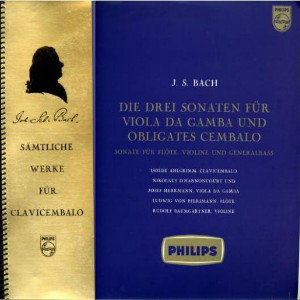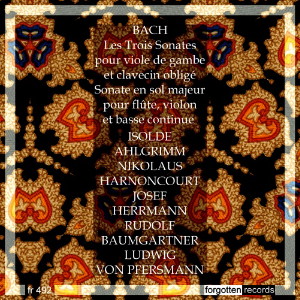 |
1 LP -
A 00327 L - (p) 1957
|
 |
| 1 CD -
fr 492 - (c) 2011 |
|
| Johann Sebastian
Bach (1685-1750) |
|
|
|
|
|
|
|
| Die Drei Sonaten für
Viola da gamba und obligates Cembalo |
|
|
|
|
|
|
|
Sonate Nr. 1 G-dur
für Viola da gamba und Cembalo, BWV 1027
|
|
13' 09" |
A1 |
| - Adagio |
3' 03" |
|
|
- Allegro, ma non tanto
|
4' 01" |
|
|
| - Andante |
2' 42" |
|
|
- Allegro moderato
|
3' 20" |
|
|
Sonate Nr. 2 D-dur für Viola da
gamba und Cembalo, BWV 1028
|
|
14' 31" |
A2 |
| - Adagio |
1' 39" |
|
|
| - Allegro |
4' 07" |
|
|
| - Andante |
4' 06" |
|
|
| - Allegro |
4' 38" |
|
|
Sonate
Nr. 3 G-moll für Viola da
gamba und Cembalo, BWV 1029
|
|
14' 38" |
B1 |
| - Vivace |
5' 48" |
|
|
| -
Adagio |
4' 39" |
|
|
| - Allegro |
4' 10" |
|
|
| Sonate
G-dur für Flöte,
Violine und Generalbass, BWV 1039 |
|
14' 12" |
B2 |
| - Allegro |
3' 21" |
|
|
| - Allegro |
3' 44" |
|
|
| - Allegro |
3' 41" |
|
|
| - Allegro |
3' 15" |
|
|
|
|
|
|
| BWV
1027-1029 |
BWV
1039 |
|
|
|
|
| Isolde
Ahlgrimm, Cembalo |
Isolde
Ahlgrimm, Cembalo |
|
| Nikolaus
Harnoncourt, Viola da gamba |
Ludwig
von Pfersmann, Flöte |
|
| Josef
Herrmann, Viola da gamba |
Rudolf
Baumgartner, Violin |
|
|
Nikolaus
Harnoncourt, Viola da gamba |
|
|
Luogo e data
di registrazione
|
Palais Liechtenstein, Vienna
(Austria): *
- 5/6 gennaio 1955 - (BWV 1027)
- 16/17 marzo 1955 - (BWV
1028)
- 19/20
marzo 1955 - (BWV 1029)
- 1955
- (BWV 1039)
|
|
Registrazione
live / studio
|
| studio |
Producer / Engineer
|
-
|
Prima Edizione
CD
|
FORGOTTEN RECORDS - fr 492 -
(1 cd) - 56' 30" - (c) 2011 - ADD
|
Prima
Edizione LP
|
Philips "Minigroove" - A 00327
L - (1 lp) - 56' 30" - (p) 1957
|
| Note |
| * = Informazione desunta
dall'Appendice 1 al testo di Peter
Watchorn "Isolde Ahlgrimm, Vienna and
the Early Music Revival", Routledge
2016. |
|
|
Notes
|
"...he plays o' the
viol-de-gamboys, and speaks three or
four languages word for word without
book, and hath all the good figts of
nature", (W. Shalespeare: "Twelfth
Night " oder "What you will") (1. Akt
- Szena 3).
Mit diesen Worten will Sir Toby Belch
beweisen, dass Sir Andrew Ague-Cheek
ein vollkommener Edelmann sei.
Tatsächlich war das Gambenspiel
wenigstens 200 Jahre hindurch win
wesentliches Zeichen standesgemässer
Bildung. Die erste, bisher bekannte
Nachricht über eine Viola da gamba,
aus dem Jahre 1495, ist mit einer
Herzogin in Mantua verbunden. Eine
ganze Reihe unter den Königin von
England waren "Gambisten", so Heinrich
VIII., Jakob I., Karl I.; die Vorliebe
für dieses Instrument ging in England
se wit, dass zur Zeit der Königin
Elisabeth in den Friseurstuben Gamben
an der Wand hingen, auf denen die
wartenden Kunden nach Belieben
musizieren konnten, damit ihnen die
Zeit nicht lang werde. König Philipp
III. von Spanien nahm Unterricht im
Gambenspiel, in Frankreich Ludwig XIV.
und Ludwig XV., dessen Tochter sich
als Gambistin malen liess; auch der
grosse Kurfürst von Brandenburg war
ein Liebhaber dieses Instruments und
es gab wohl keine, wenn auch noch so
bescheidene Resideny in Deutschland,
an der nicht Gambe gespielt worden
wäre.
In Laufe der Geschichte waren ihr
verschiedene Aufgaben zugedacht: Bis
in's halbe 17. Jh. pflegte man das
Spiel im Gambenchor, später bevorzugte
man die Gambe als Solo-Instrument, bis
sie schliesslich dem neuen Klangideal
des Violoncells und der Geige weichen
musste.
"Die vor hundert Jahren so
unentbehrliche Gambe, ohne welche
weder Kirchen- noch Kammermusik
besetzt werden konnte, die in allen
öffentlichen und Privatkonzerten das
ausschliessende Recht hatte, sich vom
Anfange bis zum Ende vor allen anderen
Instrumenten hören zu lassen..., von
diesem allgemein herrschenden und
beliebten Instrumente wird nun in der
Zeit von einem Menschenalter in ganz
Europa keine Idee mehr übrig seyn; sie
müsste denn... als ein saitenloses,
von Würmern zerfressenes Exemplar in
einer der Hof-Musikkammern wieder
hervorgesucht werden..." (E. L.
Gerber, 1746-1819, Neues hist.-biogr.
Lexikon d. Tonkünstler)
Im Schloss zu Cöthen übte der junge
Prinz Leopold auf der Gambe, Sein
Vater, der Fürst, fand die
Staatseinkünfte zu gering, um sich den
Luxus einer Kapelle gestatten zu
können. Wahrscheinlich aber war diese
Haltung mehr durch eine streng
puritanisch-calvinistische Einstellung
verursacht als durch einen zu lnappen
Geldbeutel. Jedenfalls gab die Mutter,
nach des Fürsten frühem Tod, den
Bitten ihres 12jährigen Sohnes endlich
nach und nahm drei Musiker an den Hof;
die Cöthen'sche Hofkapelle war
gegründet.
Das gab ein Aufsehen im stillen
Cöthen! "Brothdiebe, Ertzpfuscher"
bekamen die neuernannten Hofmusiker
von ihren Kollegen, den
Stadtmusikanten, zu hören - die Drei
blieben jedoch im Amt und Würden,
selbst als Leopold zur Ausbildung an
die Ritterakademie nach Berlin musste
und anschliessend - natürlich in
Begleitung des Hofmeisters - die
übliche Cavaliersreise antrat.
1713 kam Leopold wieder nach Hause, 2
Jahre später wurde er grossjärig. Als
Fürst konnte er sich nun weit mehr
seiner geliebten Musik widmen. Da kurz
vorher in Berlin die Hofkapelle
Friedrich Wilhelm I. aufgelöst worden
war, ergriff Leopold die Gelegenheit,
einige der ehemalig Königlich
Preussischen Hofmusiker in seine
Dienste zu nehmen. Bald verfügte er
über ein ausgezeichnetes Ensemble von
18 Musikern, das er "Collegium
musicum" nannte. Als jedoch die Frau
des Kapellmeisters Stricker fand, dass
sie als Sängerin zu wenig beschäftigt
sei und Stricker kündigte, fasste der
22jährige Fürst Leopold den
Entschluss, J. S. Bach an seinen Hof
zu berufen.
Bach nahm die Berufung gerne an,
hatten sich doch im Schloss von Weimar
während seiner dortigen Dienstzeit die
Verhältnisse so sehr geändert, dass er
sich nicht mehr wohlfühlte. So leicht
ihn aber der regioerende Herzog nicht
ziehen. Als Bach um seine Entlassung
bat, wurde sie ihm erst verweigert,
schlieslich wurde sein Dienst ziemlich
drastisch beendet: "6 November ist der
bisherige Concertmeister und Organist
Bach wegen seiner halsstarrigen
Bezeugung von zu erzwingender
Dimission auf der Landrichterstube
arretiert und endlich den 2. Dezember
darauf mit angezeigter ungnädiger
Dimission des Arrestes befreyet
worden".
Vielleicht empfand Bach die darauf
folgenden Jahre in Cöthen als die
glücklichsten seines Lebens: "Daselbst
hatte einen gnädigen und Music so wohl
liebenden als kennenden Fürsten, bez
welchem auch vermeinete meine
Lebenszeit zu beschliessen", schreibt
er später an seinen Jugendfreund
Erdmann. "Es musste sich aber fügen,
dass erwehnter Serenissimus sich mit
einer Berenburgischen Prinzessin
vermählte, da es denn das Ansehen
gewinnen wolte, als ob die
musicalische Inclination bez gesagtem
Fürsten in etwas laulicht werden
wolte, zumahle da die neue Fürstin
schiene eine amusa zu seyn", ist
leider der bittere Nachsatz.
Unter dem Einflusse dieser Frau wurde
der Musik bald nur mehr eine
bescheidene Rolle bei Hof gestattet,
und so entschloss sich Bach, von
Cöthen zu scheiden um Cantor in
Leipzig zu werden. "Der Fürst liebte
ihn sehr", berichtet Forkel, erfüllte
aber doch den Wunsch seines
Kapellmeisters: "Wan aber derselbe
anderweit seine Fortun vor itzo zu
suchen willens, und uns deshalb um
gnädigste dimission unterthänigst
angelanget: Als haben, Wir ihm
dieselbe hier durc in gnaden
ertheilen, und zu anderweiten Diensten
bestens recommendiren wollen",
schreibt Leopold in Bach's
Entlassungsddecret Eine Woche vorher,
am 4. April, war die "Amusa"
gestorben, doch konnte dies den Lauf
der Dinge nicht mehr ändern. Bach und
Fürst Leopold aber, blieben einander
bis zu dessen frühem Tod in herzlicher
Freundenschaft verbunden.
Unter der folgenden Regierung von
Leopolds Bruder, August Ludwig, wurde
die Kapelle auf 12 Mitglieder
vermindert, 1754 wurden alle
Mitglieder durch fürstlichen ohne
Kündigung und Pensionsansprüche
fristols entlassen. Selbst die Bitte
des Rentkammerdirektors "denen alten,
welche auf die 40 Jahre alhier
gedienet und nunmehro ausser Stande
seyn, anderwärts ihr Fortun und
dürftiges Brodt zu suchen", blieb
ungehört. Was mag das Schicksal der 4
Musiker gewesen sein, darunter sich
der Gambist Christ. F. Abel befand,
der erste, der vielleicht mit Bach am
Cembalo dessen Gambensonaten gespielt
hat? Wie mag es Kammermusikus Freytag
ergangen sein, dem Ersten, den
Leopolds Mutter, Gisela Agnes für das
Kammerquartett bestellt hatte?
August Ludwig richtete sich ein
militärisches Hautboistenkorps ein,
der grösste Teil der Musikbibliothek
war schon bald nach Leopolds Tod
verschwunden, einzig einige alte
Instrumente aus dem Inventar von
Bach's Zeit blieben stumm gewordene
Zeugen des Höhepunkts der
musikalischen Vergangenheit eines
Geschlechtes,
Wir danken Bach's Aufenthalt in Cöthen
den grössten Teil seiner weltlichen
Instrumentamusik, darunter auch die
Gambensonaten.
Der autographe Titel, in zweien dieser
Sonaten erhalten, lautet: "Sonata a
cembalo e Viola da Gamba".
Das könnte uns leicht zu der irrigen
Meinung führen, es wären Sonaten mit
Klavierbegleitung, wie wir sie später
von den Klassikern und Romantikern
kennen, bei deren Wiedergabe sich ein
Streicher meist vergeblich müht, neben
dem Tonschwall eines Klavieres zu
bestehen.
Diese Sonaten sind aber als Trios
komponiert, das heisst: drei
gleichberechtigte Stimmen sind darin
kunstwoll kontrapunktisch verarbeitet.
Eine dieser drei Stimmen, meist die
Mittelstimme, wird von der Gambe
gespielt, Bass und Sopran sind dem
Cembalo zugedacht.
Der Ton des Cembalos war meist zu
zart, um neben einem Streichoder
Blasinstrument bestehen zu können. Es
war daher üblich, die Bass-Stimme
(linke Hand) des Cembaloparts durch
ein anderes Instrument zu stützen.
Nach Belieben wurde dazu ein
Violoncello, eine Gambe, oder - zu
Bläsern - häufig ein Fagott benützt.
Überdies hatte das Barock eine
besondere Vorliebe für starke Bässe.
Der Bach-Schüler Kirnberger schreibt
in Sulzer's "Allgemeine Theorie der
Schönen Künste" 1778: "Das Wichtigste
ist hiebey das Verhältniss der Bässe
gegen obern Stimmen, damit der Bass
allzeit über alle andre Stimmen
herrsche, weil dieses seine Natur
ist". Man sollte darum in der
Kammermusik wirklich niemals auf ein
Continuo-Instrument verzichten.
Die Gambenstimme dieser 3 Bach'schen
Sonaten ist für eine siebensaitige
Gambe geschrieben. Bach fordert einen
Tonumfang, den die sechssaitige Gambe
nicht zu erfüllen vermag. Er führt die
Stimme bis zum G1, während die tiefste
Saite der sechssaitigen Gambe das D
ist. Auch die Scordatur kann hier
nicht helfen. Wer nur über eine
sechssaitige Gambe verfügt, muss die
betreffenden Stellen um eine Oktave
versetzen.
Das den Gambensonaten folgende Trio
ist eine frühere Fassung der 1.
Gambensonate. Sie ist in einer alten
Abschrift erhalten, welche von der
Hand Zulter's die Überschrift: "Trio
für zwei Flöten und Bass" trägt. Da
nicht erwiesen ist, dass diese
Besetzungsangabe tatsächlich von Bach
selbst herrührt, ausserdem das Barock
in der Instrumentwahl sehr freizügig
war, habe ich mich nicht verpflichtet
gefühlt, den Angaben Zelter's zu
folgen und habe statt zweiter Flöten
die Besetzung der Trio-Sonate des
Musikalischen opfers gewählt.
Isolde Ahlgrimm
Instrumentarium der Gambensonaten:
Siebensaitige Gambe von Christoph
Klinger, Rattenberg in Tirol 1683;
aufgefunden 1937 bei einem Trödler in
Amstetten (Nied. Österreich). 1807 war
die Gambe laut Inschrift im erneuerten
Wirbelkasten auf ein Cello
umgearbeitet worden, wobei jedoch der
originale Kopf erhalten blieb, was
ermöglichte, den Originalzustand
wieder herzustellen.
Fünfsaitige Gambe von Johannes Maria,
Nord-Italien ca. 1530.
Instrumentarium der Trio-Sonate:
Flöte von J. M. Bürger, Strassburg um
1835.
Violine: sub disciplina Nicolai Amati,
Cremona, um 1680.
Violoncello von Francesco Rugger detto
il Per, Cremona 1683
|
|
Nikolaus
Harnoncourt (1929-2016)
|

|

|
|